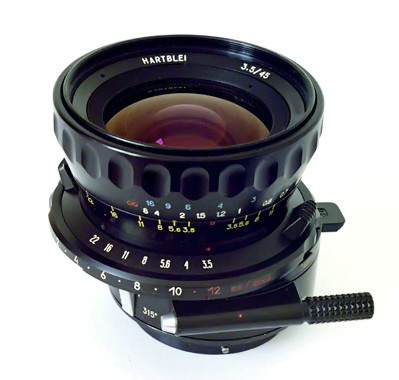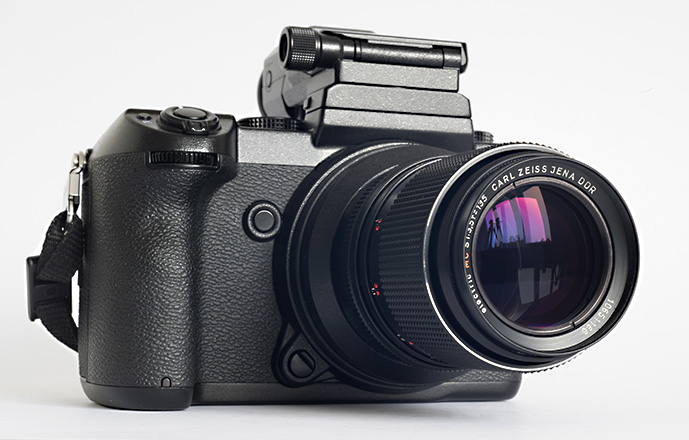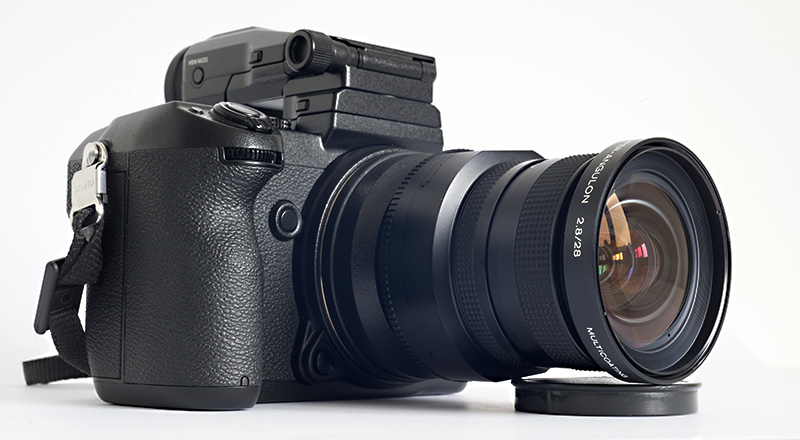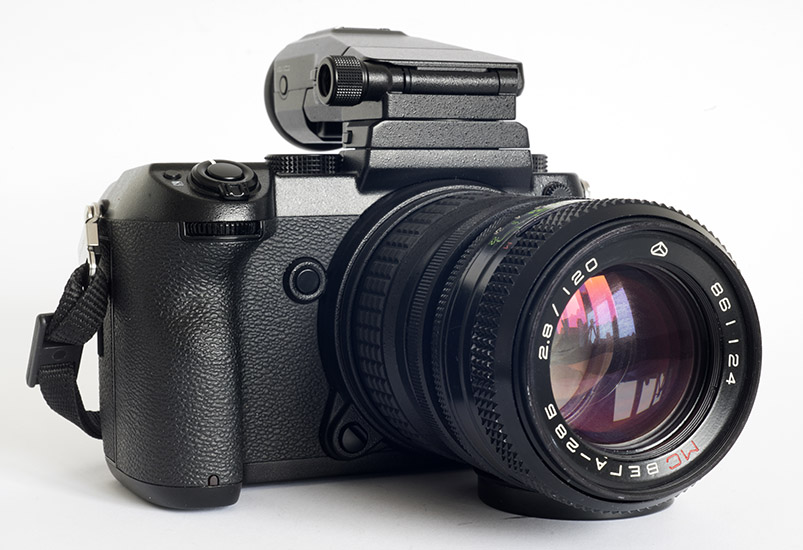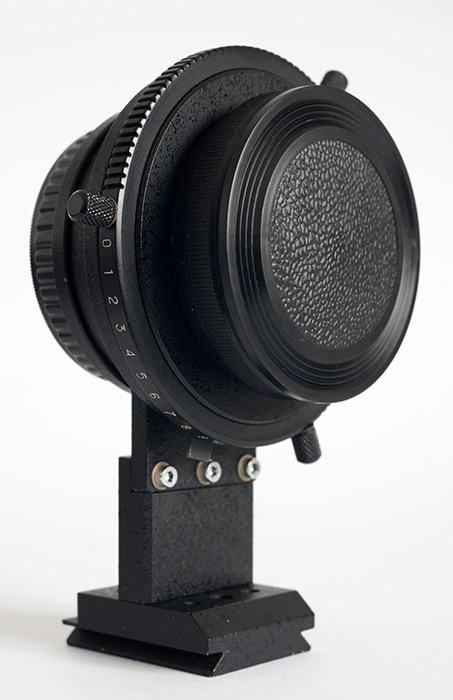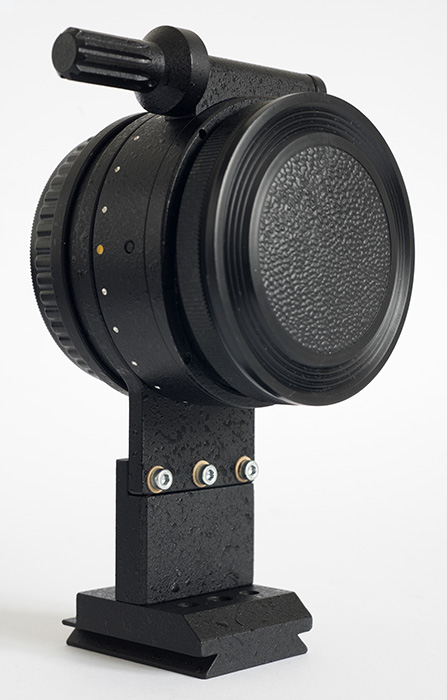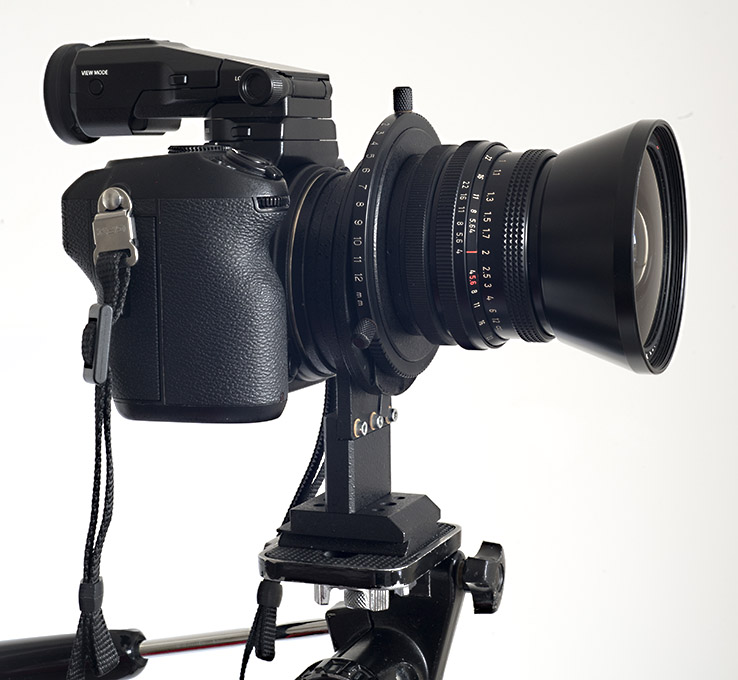by TRA
Wouldn’t it be
better to use a digital camera?
Latest
Thoughts in March 2022
Updated July 2024
In March 2022 Hermann wrote to me from Vienna:
|
“Hallo! I just studied your incredible Pentaconsix site and thought I should make some comment. I do have a Rolleiflex camera and a Pentaconsix together with 50mm Flektogon, 80mm Biometar and the 180 mm Sonnar and some useful equipment including a studio tripod. Since 2010 I work digital. I invested about 10,000 € My last camera is a Olympus OM1III with the 12-40mm 2.8 pro and 75mm 1.8 lens plus a professional printer PRO-200. With this photographic equipment I never experienced those problems wrote about in site. Of course I can "only" print A3+ and not 2m or larger but in stupendous quality. And I do not have to carry almost 10 kg but only 1.5 kg. Nevertheless the medium format cameras are fine to work with. I just prefer the digital equipment almost exclusively. Kind regards Hermann” |
Here is the reply that I sent
him:
| “Hello
Hermann Thank you for writing. I congratulate you on the excellent photographs that you have attached. I see that you have made a large investment in high quality equipment, including an A3+ printer. The world of digital cameras has made massive advances over the past 20+ years, making delays in firing the shutter insignificant with the best cameras and improving image resolution significantly, especially if one is able to spend a large sum of money, generally several thousand Euros for a new digital camera, especially if it is in the digital "medium format", which is of course a lot smaller than film medium format cameras. I occasionally use digital cameras, but almost always with lenses from the pre-digital era, mostly from Carl Zeiss Jena and Arsenal Kiev. This gives me much greater control of the image, including depth of field, and provides shift possibilities for architectural photography and tilt possibilities for product photography, either by using lenses that have these possibilities or by using a shift or tilt adapter. Putting a medium format shift lens onto a tilt adapter, or a medium format tilt lens onto a shift adapter also gives me the possibility of combining both of these features when taking certain sorts of photographs. With a shift lens or a shift adapter, for certain types of photography I can combine two or more images in software, to give a wider angle of view and higher resolution. You may wish to explore some of these possibilities with your Flektogon, Biometar and Sonnar lenses. I have found them to give excellent results on the "full frame" Sony A7Rii and on the "medium format" Fujifilm GFX 50S, using the adapters supplied by Sergey of Hartblei, which are exceptionally good. In contrast, my Foto**** Pro adapter is very poor, as the lock does not work adequately, so the lens slides down, sags or droops (tilts) forward while being used, no matter how much I tighten it up. I wish you success and enjoyment in your photography. With best wishes Mr Pentacon Six” |
Let
us now look in more detail at that option of using
Pentacon Six lenses on digital cameras. The development
of mirrorless digital cameras with interchangeable
lenses makes using Pentacon Six lenses and even lenses
from 35mm SLR cameras easy: there is almost always
enough space for an adapter between the back of the lens
and the camera.
We must remember that the formats of sensors in digital cameras are usually different from the film formats of the pre-digital era.
| Some Analogue Formats | Some Common
Digital Formats |
||
| Format name |
Frame dimensions |
Format name |
Sensor dimensions |
| (APS-C1 35mm SLR Medium Format 6 × 6 |
25.1.
× 16.7 mm) 24 × 36mm 54 × 54mm |
APS-C. “Full frame” “Medium Format” |
25.1 × 16.7 mm2 24 × 36mm 43.8 × 32.9mm3 |
Notes
1 Not that common in analogue format; introduced along with several other small formats towards the end of the 20th century
2 According to Wikipedia here on 15.3.22.
3 Here I give the dimensions for the Fujifilm GFX series of cameras. There are other cameras that designate themselves as being “Medium Format” that have sensors of other sizes.
These differences in sensor sizes have advantages and disadvantages:
| Disadvantages |
Advantages |
If the sensor
size is smaller than the film format for which the
lens was designed:
|
If the sensor size is smaller
than the film format for which the lens was
designed:
|
Adapters for using Pentacon Six Lenses on Digital Cameras
For “Full Frame” mirrorless cameras such as the Sony E cameras, it is easy to find mounts both for “analogue era” M42 lenses designed for 35mm cameras and for Pentacon Six lenses.
 Two “no name” lens adapters for Sony E mount cameras: on the left, for M42 lenses, on the right for lenses with the Pentacon Six mount [M42-P6_Sony_E.jpg] |
| On this
camera I have covered over the manufacturer’s name
to prevent it from being reflected on the subject
in close-up and macro photographs. |
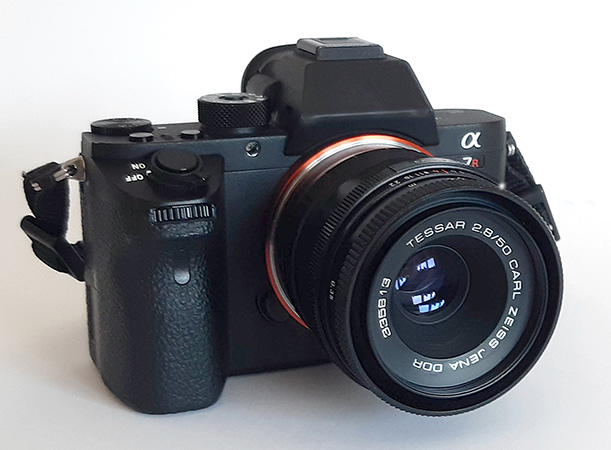 A Carl Zeiss Jena 50mm Tessar lens in M42 mount for Praktica cameras on a Sony “Full Frame” camera. This lens gives superb results and is regularly used for “product shots” on this website. [50mmT_Sony_E.jpg] |
|
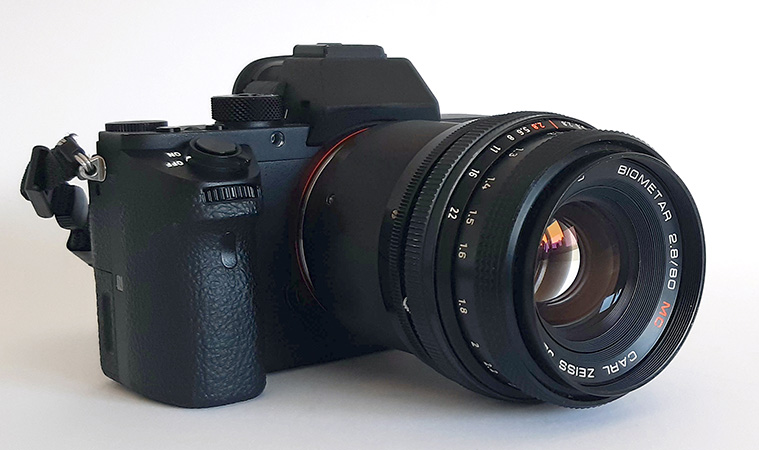 A Carl Zeiss Jena 80mm Biometar lens in Pentacon Six mount on a Sony “Full Frame” camera On the 24 × 36mm format, this lens is ideal for portraits, but also has many other uses. Its quality is well known from its use taking pictures on the Pentacon Six. [80mmBm_Sony_E.jpg] |
Using Pentacon Six lenses on a “Medium Format” digital camera
Lenses designed for the Pentacon Six are of course ideal for the newer “Medium Format” digital cameras. In the world of digital photography, this title is claimed by any manufacturer of a camera that has a sensor larger than the “Full Frame” 24 × 36mm format. As indicated above, the Fujifilm GFX cameras have a sensor that is 43.8mm wide × 32.9mm high. Fujifilm currently has five cameras in this range:
- the Fujifilm GFX 50R, the design of which is inspired by rangefinder cameras
- the
Fujifilm GFX 50S, the design of which is inspired by
SLR cameras, therefore with a viewfinder of
approximately pentaprism shape (although it is
electronic and does not contain a pentaprism).
These two cameras generate images that are
approximately 51 Megapixels in size.
- the Fujifilm GFX 50S II, which is a newer version of the above camera
- the Fujifilm GFX 100S has a built-in vertical grip and generates images that are approximately 102 Megapixels in size
- the
Fujifilm GFX 100S II, which is a newer version of the
above camera, without the vertical grip and somewhat
smaller, partly due to the use of smaller batteries.
| Hartblei
Cameras . |
||
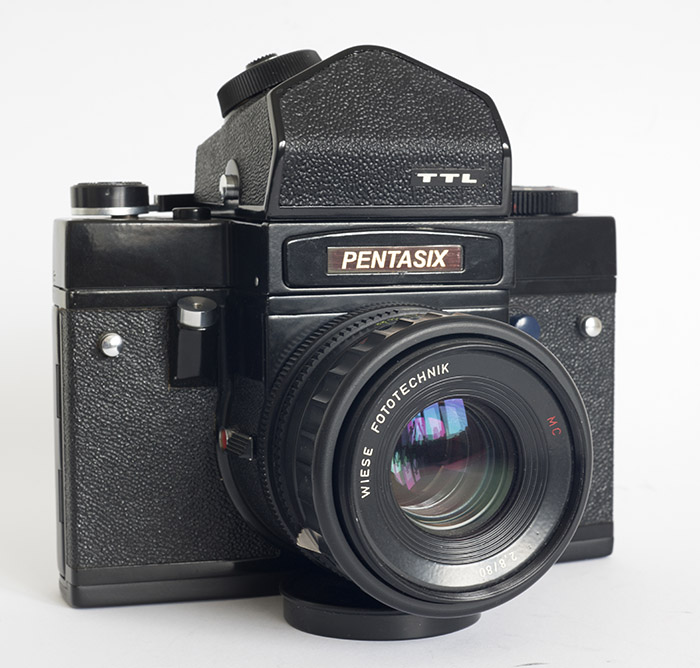 [pentasix01.jpg] |
|
The name Hartblei will
probably be well known to visitors to this
website. About the turn of the century, this
name appeared on cameras that were highly upgraded
versions of the Kiev 60 and Kiev 88 cameras. As
reported here, Wiese
Fototechnik in Hamburg, Germany, worked closely
with Hartblei for a number of years and sold
Hartblei products re-badged under the Wiese or
“Pentasix” name. The camera shown here is a much-improved Kiev 60:
|
| Hartblei
Lenses |
||
| Then Hartblei produced a
series of lenses in Pentacon Six mount, based on
Kiev Arsenal lenses for the Kiev 60, but with
vastly-improved barrels, multi-coating and
silky-smooth lubrication. For reports on
some of these lenses, see the links on the data
page on Pentacon Six lenses, here. Click on the
image to the right to see it larger.
|
|
The Hartblei 45mm
Super-Rotator Shift-Tilt lens
[c370_31a_s.jpg]
|
Hartblei Adapters
For a number of years, Hartblei, based in Kiev (now known by the Ukraininan name of Kyiv), has also produced superb lens adapters. We will mention a few of them here. The first adapters of which I am aware were to enable Pentacon Six and M42 lenses to be used on various cameras. My experience is limited to their adapters for Fujifilm GFX cameras, which are superb. They also now produce fantastic adapters to enable Mamiya RB67/RZ67 lenses to be used on the Fujifilm GFX series cameras.
“Basic” Hartblei adapters for the Fujifilm GFX
| Hartblei make simple but
strong adapters to enable Pentacon Six lenses to
be used on Fujifilm GFX cameras. The results
should be superb, as Pentacon Six lenses are
designed to cover a larger format than the
Fujifilm GFX 43.8 ×
32.9mm sensor. What is perhaps surprising is that Hartblei also also make an adapter for mounting M42 lenses onto the Fujifilm GFX cameras. This may be unexpected, as M42 lenses are not designed to cover the size of the GFX sensor. However, some of them do cover it. In fact quite a few lenses for 35mm SLR cameras perform excellently on the Fujifilm GFX cameras. Quite a few, but not all, so it is advisable to do some tests before using a given 35mm camera lens on the GFX. One needs to check especially for vignetting (darkening of the corners) and resolution outside the original intended area of 24mm × 36mmm. Generally, wide angle lenses are not good at covering the larger sensor size, but lenses for 35mm cameras that I have tested with a focal length from about 100mm on have performed extremely well on the GFX. |
|
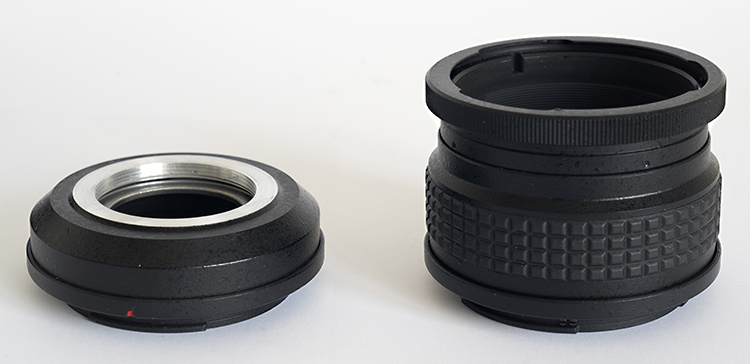 On the left, an adapter to
use M42 lenses and on the right to use Pentacon
Six lenses on the Fujifilm “Medium Format” GFX
digital cameras
[M42_P6_GFX.jpg] |
M42 lenses on the GFX
| |
Here we see a 135mm Zeiss
f/3.5 Sonnar lens – the best of all the M42
lenses that I tested! It could be a great
portrait lens on this camera, and it is small
and light-weight.
[135CZ_on_GFX_s.jpg]
|
|
|
|
| Click on
the above two images to see them larger. |
||||
Pentacon Six lenses on the GFX
| |
The Carl Zeiss Jena 80mm
Biometar lens in Pentacon Six mount on the
Fujifilm GFX 50S, via the Hartblei adapter
[80Bm_GFX_01_s.jpg] |
|
||
| Click on the above two images to see them larger. | ||||
Hartblei Pentacon Six Lens Shift and Tilt adapters for Fujifilm GFX cameras
We called the above two Hartblei GFX adapters “Basic” Hartblei adapters for the Fujifilm GFX, our term, not theirs. But we have used it because Hartblei also make Shift and Tilt Adapters for using Pentacon Six mount lenses on Fujifilm GFX cameras. As we would expect from Hartblei, these adapters are sturdily made and can take any lens, no matter how heavy. They also provide a strong tripod mount base that will take a standard tripod screw, and they also incorporate an Arca-Swiss compatible “Quick Release” plate.
| |
The Hartblei Shift
adapter for Pentacon Six lenses on Fuji GFX
cameras provides 12mm of shift, and as the
mount can be rotated through 360°, the shift
can be in any direction.
|
[P6_Shift_GFX_01_s.jpg]
|
|
The Hartblei Tilt Adapter
for Pentacon Six lenses on Fuji GFX cameras provides
up to 8° of tilt, and as the mount can be
rotated through 360°, the tilt can be in any
direction, to increase depth of
field, or, used in the opposite direction, to
reduce it if required.
|
[P6_Tilt_GFX_01_s.jpg]
|
|
| Click on the above two images to see them larger. | ||||||
Here we show two examples of Carl Zeiss Jena lenses in Pentacon Six mount used on a Fuji GFX50S via the Hartblei Shift and Tilt adapters.
| |
50mm Flektogon, here fully
shifted up
The results with this combination are SUPERB. By shooting with the adapter shifted in various directions, and stitching the images together, one is able to obtain coverage equal to a lens of approximately 32mm, and the resolution of the composite picture is massive. (See below.) |
|
|
|
| Click on
the above two images to see them larger. There is also a Hartblei Parallax-Free Shift
Adapter for
mounting Pentacon Six mount lenses onto
Fujifilm GFX camera bodies. What
advantage does this offer? Shift
images are generally better taken using a
tripod. If various images are to be
taken, perhaps with the shift in different
directions, for subsequent stitching
together, using a tripod is virtually
essential.
For the regular shift adapter, shown above, the adapter’s tripod mount is at the back of the adapter, behind the shift mechanism. With the camera-adapter-lens combination mounted on a tripod via the adapter, the camera will not move, and the lens can be shifted up and down (or in any other direction!) in front of it. With the parallax-free shift adapter, shown below, the adapter’s tripod mount is at the front of the adapter, in front of the shift mechanism. With the camera-adapter-lens combination mounted on a tripod via the adapter, the lens will not move, and the camera can be shifted up and down (or in any other direction!) behind it. Why is this important? If your image contains components that are much nearer to you than the background, as you move the lens, those components will appear to move in relation to the background, so they will obscure different parts of the background. This will usually cause problems with stitching. If the lens is not moved, but the camera is moved behind it, those components will be in the same position in relation to the background. See a further explanation here. (Look for “Parallax-Free Mount”.) Here are some pictures of the Hartblei Parallax-Free Shift Adapter for using Pentacon Six lenses on Fujifilm GFX cameras. Click on the
above three images to see
them larger.
|
||||
Examples of the use of the Hartblei shift adapter for Pentacon Six lenses on Fujifilm GFX cameras can be found here.
As I stated in my reply to Hermann above, putting a medium format shift lens onto a tilt adapter, or a medium format tilt lens onto a shift adapter also gives me the possibility of combining both of these features when taking certain sorts of photographs.
It is of course also possible to put a shift lens onto the shift adapter and use the combined shift of both items (for instance, 12mm + 12mm = 24mm of shift), subject to the covering power of the lens.
Likewise, a tilt lens can be put onto the tilt adapter, to increase the range of total tilt (often 8º + 8°), to increase (or intentionally reduce!) the effective sharp area of the image, again subject to the covering power of the lens.
Using Pentacon Six lenses on the Fujifilm GFX 50S
For
the results of my initial tests of using Pentacon Six
and M42 mount lenses on the Fujifilm GFX 50S, see here.
For
more information on the covering potential of lenses
(their “image circle”), see here.
Hartblei Mamiya 67 lens Adapter to Pentacon Six Bellows, with an Adapter for Fujifilm GFX cameras
This adapter
set consists of two rings:
This
image was captured on my phone. The
poor quality is immediately obvious, even
when reproduced small on this website.
Nevertheless, those who are curious can see
a larger copy by clicking on the image.
|
|
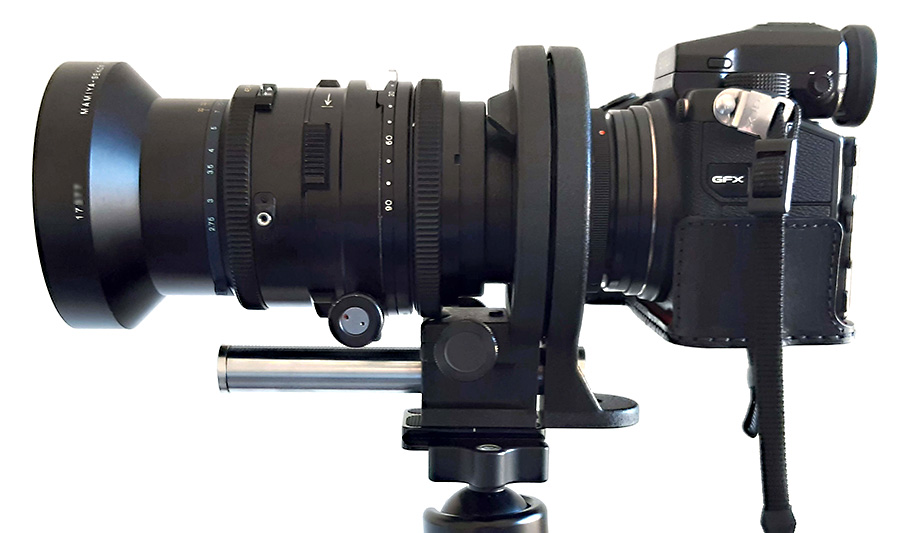
[75_P6bell_GFX_01_s.jpg]
|
Hartblei also produces an extremely sophisticated shift adapter to mount Mamiya 67 lenses on Fuji GFX cameras. This adapter permits shift up to 12mm in any direction, and of course it includes a focussing mechanism that can be adjusted by hand but is best driven by a Follow Focus geared mechanism such as the FOTGA DP500 2S or III.
| The
apparent difference between the position of the
camera viewfinder in this image and in the
preceding one is due to the fact that here I
have added the Fuji Viewfinder Tilt Adapter
between the top of the camera and the
viewfinder. This enables the viewfinder to
be raised up to 90° in relation to the camera
(effectively, an electronic angle finder), as
well as to be swivelled to the left and to the
right to permit easier viewing when standing
behind the camera is either not possible or is
not desirable (perhaps to avoid casting a shadow
onto the subject, for instance, in macro work). For an introduction to this system, see here. |
|
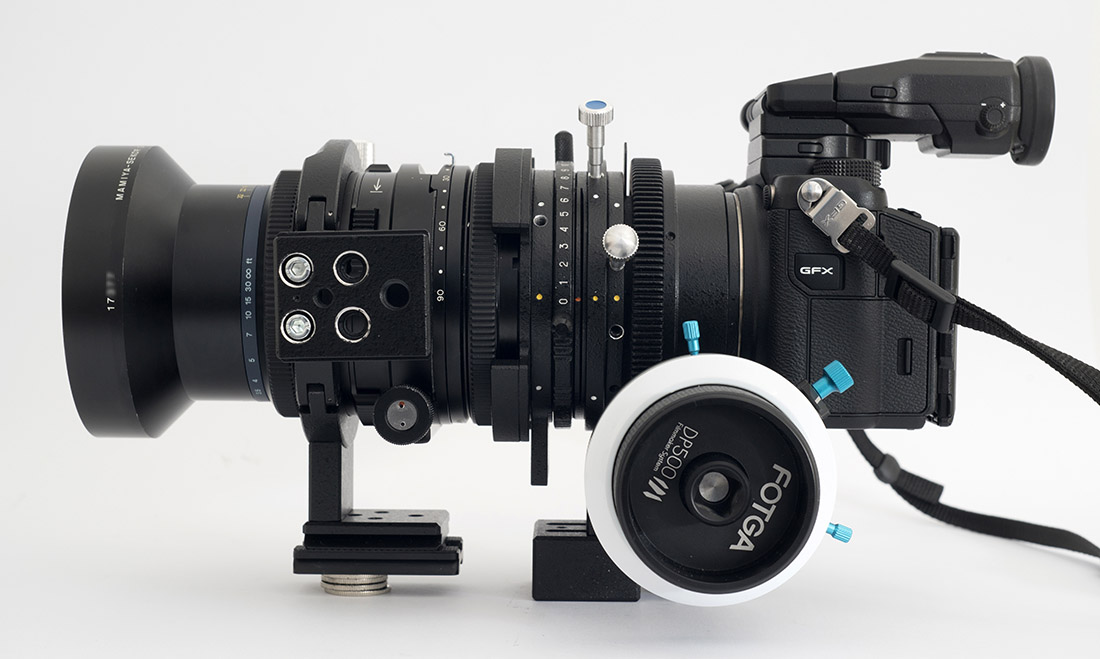 The combination of Mamiya RZ67 75mm lens, Hartblei focussing and shift adapter, Fotga Follow Focus system and Fujifilm GFX camera This is clearly designed to be used mounted on a tripod. [Hartblei_set_08_s.jpg] Click on the above image to see it larger. |
|
| Where can
I buy Hartblei gear? |
||
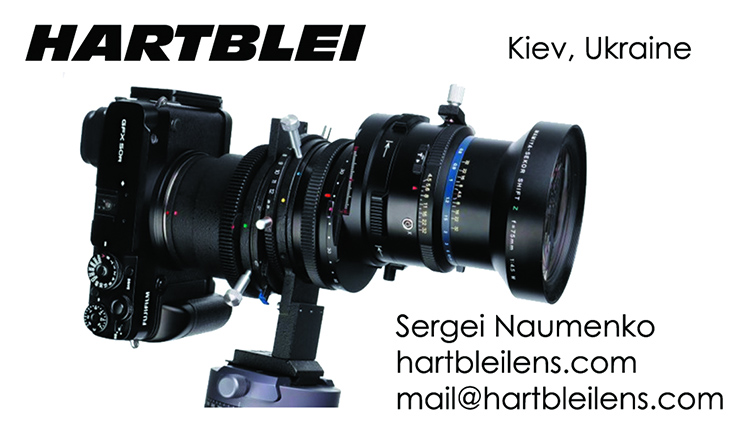 [hartbleilens_s.jpg] |
|
The genius behind Hartblei is
Sergey Naumenko, a highly-skilled engineer, to
judge from the equipment that he designs and
manufactures. His eBay seller name is “hartbleilens”. His website is https://hartbleilens.com/ Click on the “business card” on the left to see it a little larger. |
Counting the Cost
The Hartblei adapters are not going to be cheap, but nor are the Fujifilm lenses for these cameras. One can expect to pay in the region of £1,500 for the cheapest of Fujifilm’s GFX lenses, and many lenses are in the range £2,200 – £2,500 each. For the owner of lenses in the Pentacon Six mount, buying one or more Hartblei adapters could well be the best way to go.
And Hartblei adapters are at the pinnacle of quality, with the best design features and no internal reflections (in contrast with adapters from some other well-known sources!). Lenses held in Hartblei adapters don’t “droop”; they stay where you put them. Remember that many lenses with a Pentacon Six or Mamiya 67 mount are quite large and heavy. Adapters from some other manufacturers are just not well enough designed, nor are they strong enough to hold the lenses where they are put. Their lack of an adequate internal finish also causes internal reflections that reduce contrast and often degrade the image to the point where it is unusable.
Using the Mamiya RZ67 75mm lens with the Hartblei adapter, it is possible to use the lens shift sideways and the Hartblei shift up and down, to shoot nine images in three rows of three, which Christopher Leggett calls “DAS”, which stands for “Dual Axis Shift”. The images then need to be stitched together on a computer. At the time of writing (16th March 2022) his video on using a prototype version of the above outfit, entitled “GFX 100 Using HARTBLEI RBZ-S Adapter with Mamiya 75mm RZ 67 Lens with DAS” can be seen on YouTube here: https://www.youtube.com/watch?v=Fg7BSal1ILw It is highly recommended. See also his video “Macro Old and New”, here: https://www.youtube.com/watch?v=P3pNHVDHrao (Last viewed on the same date)
Computer requirements
One must remember that going down the route of high-resolution digital capture is a long journey with many implications, some of them quite costly. In my short experience with this outfit, I have found that when nine images shot on a “mere” Fujifilm GFX 50S are stitched together, the resultant image is a little over 500MB in size. So two images will occupy more than a Gigabyte of computer storage space. What is more, processing such large files requires a powerful computer. Christopher Leggett reports that his 2019 Mac Pro Desktop computer has the following specifications:
- Processor:
2.5 GHz 28-core Intel Xeon W
- RAM Memory: 512GB 2933 MHz DDR4
- Graphics card: AMD Radeon Pro Vega II with 32 GB memory
Christopher gives some information on his computer system and monitors here https://www.youtube.com/watch?v=FB4uOXZRaZs&t=70s (viewed on 18.3.22).
The Future
So have I stopped using the Pentacon Six camera? Not at all! When I go on a trip, I prefer to “travel light” with a Pentacon Six and a few lenses! Likewise at home, I sometimes prefer the simplicity of using a Pentacon Six and some of the superb lenses made for it, when I don’t need a 500 Megapixel file and can settle for an image that has a file size of a “mere” 300 or so Megabytes, without any need to stitch component images together!
